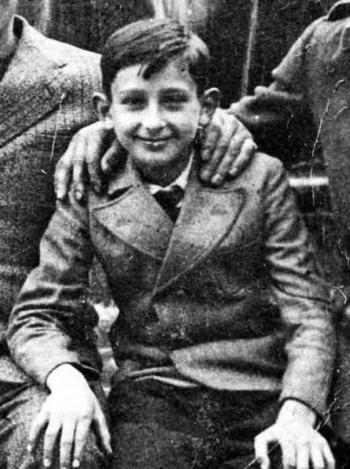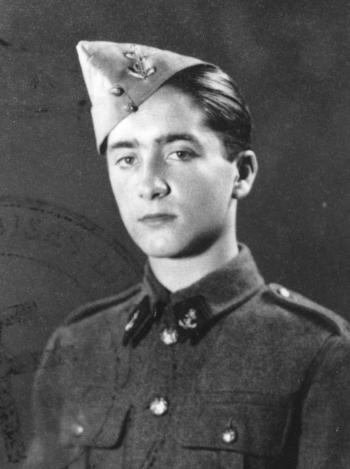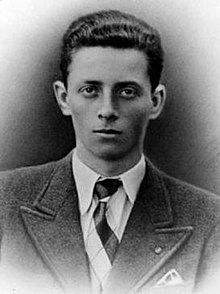Forum Discussion
5 Replies
- Moskolonel6 years agoLegend
Louis Cortot

The son of a tinsmith, Louis Cortot joined the resistance at the age of fifteen. In May 1942, he and his group, the Special Organization, participated in the grenading of a convoy of * Youth at Trappes.
After the war, he was president of the national association of veterans of the Resistance and a member of the Council of the Order of the Liberation. He joined Dassault Aviation as an adjuster, transferred to the equipment department in 1961, hydraulic fitter technical agent in 1966, and preparer in 1976. He retired in 1986. He died on March 5, 2017 at the age of 91. He is buried in the vault of the Order of the Liberation in the Père-Lachaise cemetery.
- Moskolonel6 years agoLegend
Lazare Pytkowicz

was born on February 29, 1928 in Paris. His father is a cabinetmaker.
At the time of the armistice, Lazare was twelve years old; he lives with his family on rue de Clignancourt in Paris. He engaged in small anti-German propaganda activities with her. He was arrested on July 16, 1942 during the Vel 'd'Hiv' roundup. Taking advantage of a stampede, he manages to escape from the velodrome.
Under the pseudonym "Petit Louis", he became a liaison officer in Lyon for the Frankish groups of the United Resistance Movements (MUR) when he was not fifteen. At the end of June 1943, he was responsible for contacting the wife of a jailer in the Montluc prison where Jean Moulin and the resistance fighters arrested in Caluire were interned to try to find out their entries and exits from the prison.
On October 24, 1943, Petit Louis was arrested by the Gestapo, on the Guillotière bridge in Lyon. When questioned, he manages to escape. Immediately he gets back in touch with his group and resumes his activity. "Burned" now in Lyon, he was sent to Paris as liaison officer for the Frankish groups of the National Liberation Movement.
On January 27, 1944, Porte Dorée in Paris, he was arrested a third time, this time by the Militia. He was successively transferred from Paris to Lyon, Vichy and Moulins under the responsibility of the Militia. It is then handed over to the Gestapo. In July 1944, the Germans, before the rapid advance of the Allies, decided to transfer the prisoners from Moulins to Paris before deporting them to Germany. At the Gare de Lyon, on July 14, when he was deported, he managed to escape again by drowning in the flood of travelers.
After the liberation of Paris, having no news from his parents and his sister (they will not come back from Auschwitz), he is taken care of by the family who hosted him in 1942 and who encourages him to take back his studies. He will have a career at Monoprix.
He will campaign all his life with the Communist Party, in the section Large careers, in Paris (18th), of which he will be one of the secretaries.
He died on October 12, 2004 in Paris. He is buried in the Saint-Vincent Cemetery in Montmartre.
![16-07] La rafle du Vel d’Hiv : l’histoire de Lazare Pytkowicz](https://www.les-crises.fr/wp-content/uploads/2017/07/Lazare-Pytkowicz-3.jpg)
- Moskolonel6 years agoLegend
Léon Bouvier

Léon Bouvier was born on September 28, 1923 in Vienna, Austria, to Polish parents.
At the age of 10, he asked his parents to send him to study in Paris. He entered the Lycée Michelet in Vanves as a resident of the French state.
In the summer of 1939, he learned of his mother's death and joined his father in Warsaw where he witnessed the German invasion and the bombing of the city.
He then left Warsaw and, after a long journey, took refuge in Lvov, in territory annexed by the Soviet army under the German-Soviet pact. Without means and not speaking Russian, he spends the harsh winter 39/40 by selling Soviet newspapers in the street.
In the spring of 1940, thanks to the intervention of the French Consulate in Moscow, he obtained papers allowing him to leave the Soviet zone.
He then leaves for Romania where he arrives to learn of the invasion of France and the signing of an armistice by the new government of Marshal Pétain.
He then decided not to return to France as the French consular authorities in Bucharest had suggested, but to join by his own means the fighting units of free France in the process of being set up in the Middle East.
After a long journey which leads him, with the help of the British diplomatic authorities, to Istanbul then to Haifa, he finally arrives at Ismailia, in Egypt, where he engages in free France, with the 1st Battalion of marine infantry (1st BIM).
He is then 16 years old and therefore hides his papers to pretend that he is 18.
He was sent to the front as a driver during the first British attack in Libya under the command of General Wavell. Back in Egypt, he was placed under the orders of Commander Pierre de Chevigné. The latter, guessing the age of Léon Bouvier, refused to take him to Eritrea and sent him, in the winter of 1940-1941, to the French lycée in Cairo to take the baccalaureate.
Young bachelor, Léon Bouvier joined the Free French Forces in the spring of 1941 and took part in the Syria campaign.
Assigned to the Pacific Battalion (BP 1) in September 1941, he was first secretary to the Divisional Staff but soon asked for a more active assignment and was then paid as a driver for the 101st Auto Company the following December.
Left for Libya with the 1st Brigade of General Koenig, the soldier 2nd class Bouvier is engaged in the night supply convoys in ammunition of the French forces besieged in Bir-Hakeim. On June 8, 1942 during a convoy, as he rushed to extinguish the fire in his truck caused by the bombing of a German plane, he was seriously injured and had his right arm amputated on the battlefield.
After a long repatriation journey via Cairo and Alexandria, he recuperated at the French military hospital in Beirut, where he was made a Companion of the Liberation by General de Gaulle.
He embarked in Damascus for England on Christmas Eve 1942 and was assigned as a corporal at the National War Commissariat; appointed adjutant on May 1, 1943, he entered the Cadet School of Free France on the same date, from which he graduated aspiring to the Corsican and Savoy promotion in December 1943.
In April 1944, Léon Bouvier was assigned to the Military Administrative Liaison Mission (MMLA) and then participated in the French campaign as an attaché to Colonel de Chevigné; he attended the liberation of Paris, Metz and Strasbourg before being seconded in February 1945 to the Ministry of Foreign Affairs.
Promoted lieutenant, he was demobilized in January 1946 and left to study in Montreal before returning to France where he successfully passed the entrance exam to the Ministry of Foreign Affairs.
He then began a long diplomatic career which led him to represent France in many countries. He notably exercised the functions of First Secretary of Embassy in Stockholm in 1962, of Economic Adviser in Berlin in 1965.
After being a student at the IHEDN and seconded to the office of the President of the National Assembly, he was sent in 1972 as consul general to Frankfurt am Main.
He was then appointed Ambassador to Paraguay in 1977, Ambassador to Chile in 1981 and then to Denmark in 1985.
He was raised to the dignity of Ambassador of France in 1987 before retiring the following year.
He was a member of the Council of the Order of the Legion of Honor since 1992 and a member of the Council of the Order of the Liberation since 1995.
Léon Bouvier died on July 23, 2005 in Paris. He is buried in the Montrouge cemetery
- flyinghorse1016 years agoSeasoned Ace@Moskolonel Wow......
- Moskolonel6 years agoLegend
Henri Fertet

Fertet was born on 27 October 1926 in Seloncourt, Doubs, France, to primary schoolteachers (French: instituteur [fr]). His father too was named Henri; the sources do not record his mother's name. He had a brother, Pierre, who was three years younger. His first schooling was at Seloncourt, where his parents worked. In 1937, the family moved to Velotte in Besançon, where the younger Henri attended the Lycée Victor-Hugo de Besançon. He was determined, lively, intelligent, and affectionate; he was passionate about archaeology and history.
Career
During the school summer holidays of 1942 while World War II was ongoing, he joined a Resistance group in Larnod (near Besançon) led by Marcel Simon, a 22-year-old farmer. In February 1943, that group (which had about thirty members, Fertet being the youngest) integrated itself into the Francs-Tireurs et Partisans (FTP) under the name of Groupe Guy Mocquet [fr].Groupe Guy Mocquet mounted thirty-one known operations between November 1942 and July 1943. Fertet took part in three of them: on 16 April 1943, a night attack on an explosives depot at Fort Montfaucon [fr]; on 7 May, the destruction of a high-tension electricity pylon near Châteaufarine; and on 12 June, an attack by him and Marcel Reddet on a German customs officer to steal his weapon, uniform, and papers. Fertet shot and fatally wounded the officer, but the unexpected arrival of a motorcyclist meant that Fertet and Reddet failed to seize the documents.
Capture
Groupe Guy Mocquet was then actively hunted down. Several members were arrested in June. In the early hours of the night of 2–3 July, Fertet was arrested at his family home at the Lycée, taken before the Feldkommandantur (a German military court), committed to Butte Prison [fr] in Doubs, held in solitary confinement, and tortured.On 15 September, twenty-three prisoners from three Resistance groups were brought before Feldkommandantur 560 to answer for crimes of which they were accused. The trial lasted four days. Despite the able advocacy of their lawyers, Paul Koch and Fernand Mouquin, seventeen of them were sentenced to death on 18 September. Simon and Reddet were among them; Fertet was the youngest. Under German law, no-one under the age of 18 could be sentenced to death barring exceptional circumstances. The court ruled that the cases of Fertet (age 16) and Reddet (age 17) were exceptional. The lawyers filed legal appeals; Henry Soum, the préfet of Doubs, Maurice-Louis Dubourg [fr], the Archbishop of Besançon, and the Swiss consul pleaded for general mercy. The sentence of one of the condemned, André Montavon, a 24-year-old Swiss national, was commuted to a term of imprisonment.
Execution and burial
At around dawn on Sunday, 26 September, the sixteen condemned men were told that their appeals had been rejected. They were provided with writing materials and given the opportunity to compose a last letter. They were taken to the Citadel of Besançon and, between 7:36 and 8:25 AM, shot in batches of four. The German officer who commanded the execution party reported that they had all refused blindfolds and died bravely, shouting "Vive la France!"Eight of the sixteen, including Fertet, were buried in Saint-Ferjeux Cemetery [fr], Besançon. In defiance of German orders, local people covered their graves, identified only by numbers, with flowers. After the war, Fertet's body was exhumed and cremated; his ashes and those of his father, who had died in the meantime, were scattered at Sermoyer, Ain.
About Battlefield V
Recent Discussions
- 2 days ago
- 3 days ago
- 5 days ago